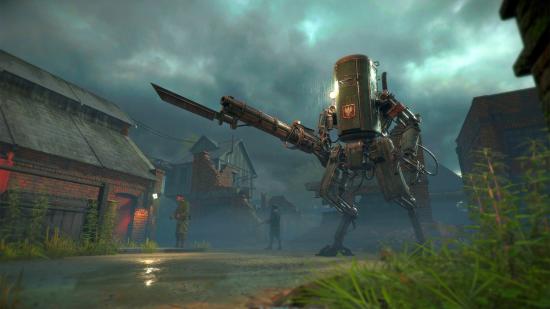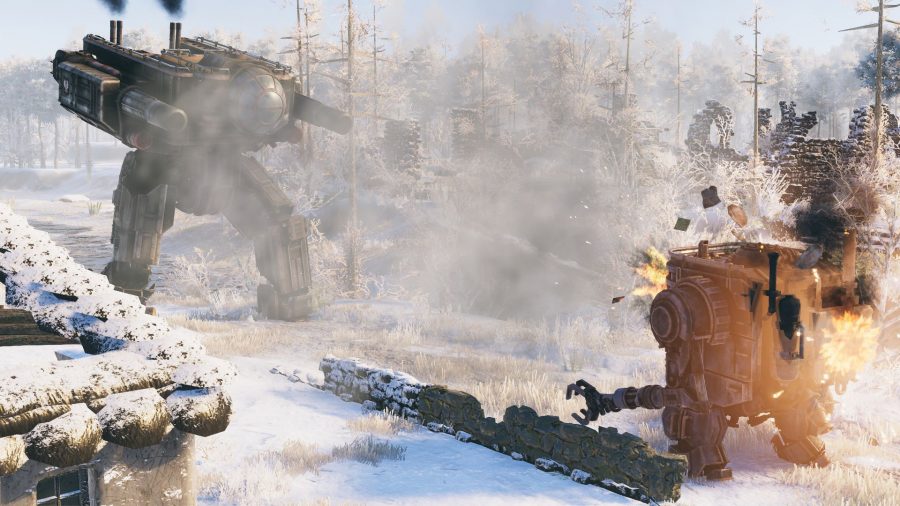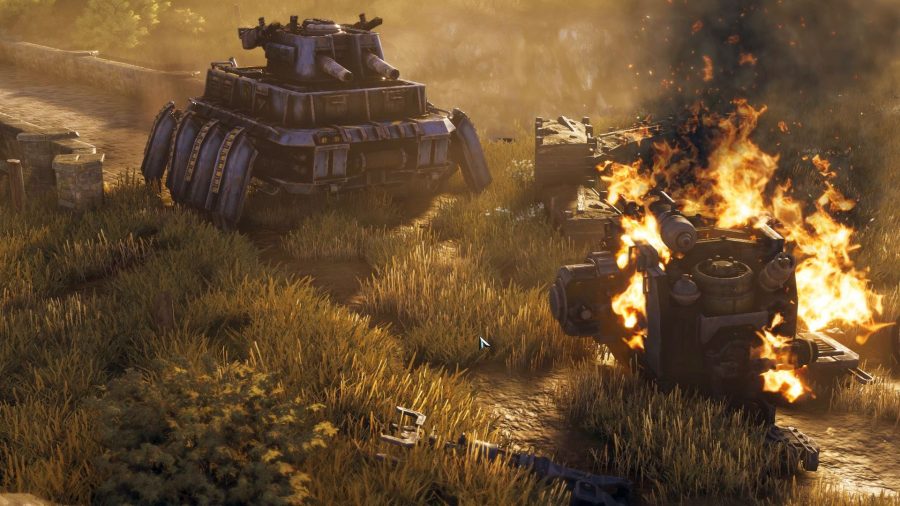Real-time strategy never really went away, but it’s hard to deny that the genre has seen stronger days. Mention RTS in certain company, in fact, and the conversation will inevitably gravitate toward the late greats: Command & Conquer, StarCraft, Company of Heroes. The very innovations subsequent games used to try to carve out their own place in the RTS landscape seem to have diluted the genre beyond recognition – which may be why the time is ripe for a game like Iron Harvest.
Iron Harvest is instantly familiar, and not only to folks who have been following the work of artist Jakub Różalski, whose dieselpunk 1920+ scenes caught fire on social media several years ago and wound up inspiring the board game Scythe. It’s an RTS in the classic form – anyone who has touched a Company of Heroes or Men of War title will instantly feel right at home playing Iron Harvest. You command squads of soldiers who will magnetise themselves to bits of cover. It’s a game of territorial control, with maps divided into small sectors which players capture in order to hasten the acquisition of resources and expand their armies.
While Iron Harvest has come up with (as well as borrowed) a few of what someone might uncharitably describe as gimmicks, the foundation of the game is set solidly in established strengths: Company of Heroes worked brilliantly, so why not just do that again? With a few notable exceptions, that seems to be what King Art Games has done, and the result is surprisingly refreshing.
Tobias Stolz-Zwilling is a large man with a meticulously groomed red beard that’s visible from across the expo floor, and he’s handling PR for Iron Harvest. He walked me through a few select missions from the campaign at PAX East in Boston, and assured me that if I had played Company of Heroes, that I was well prepared for Iron Harvest. My squads scrambled across Polanian farmland, taking cover behind stone walls, in trenches, or among scrubby bushes. It’s a setting that feels most similar to the Russian fields of Company of Heroes 2, and might be hard to tell apart at a glance – if it weren’t for the towering dieselpunk mechs stomping around the battlefield.

“I like this one, here,” he says, pointing to a PZM-7 ‘Smialy,’ a relatively small Polonian recon mech that’s hefting a long rifle. “He is weak, but he’s extremely fast, so you can use them to outrun the opponent and try to quickly destroy the HQ. Once he levels up, he’s able to use his bayonet to slice open other mechs. Pretty cool.”
Cool indeed – I find that I can use my Smialy as an effective skirmisher when enemy armour shows up, running around to flank and getting off pot-shots while the bulkier mechs slowly wheel around to face me. But it can’t stay in one place for long: sustained fire from enemy mechs or crew-served weapons found on the battlefield can make short work of the Smialy’s light armour, and Tobias recommends I send it back for repairs.
For more APMs: check out the best RTS games in 2020
There’s another whiff of Relic’s RTS design philosophy in the air as I tap the ‘R’ key – it’s a retreat command, and tapping it while you have any unit selected will instruct them to pull back and return to your HQ as quickly as possible. Once there, your squads can be filled out with reinforcements, and engineers can set to work welding your metal monsters back together. It’s always cheaper, Tobias hinted, to repair and reinforce rather than to recruit or build new units.
Mechs come in a wide variety of shapes and sizes, and each has a unique but easily understandable role. The Saxons have the Wotan, which functions as the eight-legged version of a German StuG tank destroyer, while Polania’s apex mech is the Tur – a truly massive mobile artillery platform that looks as though the designers of the B-17 Flying Fortress had learned halfway through production that they were actually supposed to be making a gundam suit.
These mechs have an imposing but natural-feeling presence on the familiar battlefields of Iron Harvest – if they’re a gimmick, they don’t feel gimmicky. As I pushed out from my HQ to capture territories, I found my mechs could hold the line as I cycled infantry squads back and forth, telling the wounded to retreat and replenish and sending full units back out to the fight.
Iron Harvest’s single-player campaign, which Tobias says will comprise 21 missions that each take 45 minutes to an hour to complete, is filled out with an hour’s worth of fully motion-captured cutscenes. Each faction has unique hero units, such as Polania’s young leader Anna, a sniper who rides around on her pet bear Wojtek. In the story mission I played, Anna led a squad alongside a captured supply train through a snowy forest. I used her sniper ability to pick off soldiers manning crew-served weapons, and sent Wojtek bounding forward to sow chaos among enemy lines. As with the lumbering, massive mechs, Iron Harvest’s heroes blend seamlessly into the rest of the game experience, with a no muss, no fuss presentation that hews closely to the design of Company of Heroes and Dawn of War.
My hour with Iron Harvest left me looking forward to playing more. I didn’t get to see any of the Rusviet faction, the 1920+ corollary to Russia immediately prior to the February Revolution. I’m curious to see how the factions are balanced against each other, and how each one’s unique mechs fit into that puzzle. While the mechs are fun – and it’s a particular delight to see them smash through wooden structures that realistically crumble and splinter beneath their feet – I’m more drawn to Iron Harvest’s unfussy, lunch-bucket approach to RTS.
Tobias, on the other hand, enjoys some of the game’s more aesthetic touches.
“When you play the game and everything is exploding everywhere, I really feel like you can almost smell the burnt oil and stuff,” he says. “It makes you really feel powerful.” He’s right: you can, and it does.
Iron Harvest launches on Steam on September 1.


